I often found the engine’s help too weak when stopping or when sailing under engine against wind and waves. Not in the sense of counter-bolting on longer distances, which is out of the question for me anyway, the ship sails too well for that. At the cross, I’m usually still faster and more comfortable than my comrades with the “iron genoa”. But when leaving the harbour or in narrow channels, it is sometimes unavoidable to use the engine briefly against wind and waves. And if there is not enough power available, it can become unpleasant or even dangerous.
For example, at the end of September 2020, in the Kroghage Dyb near Gedser, in a strong northerly wind with 6 – 7 Beaufort upwind and a ridiculous wind wave of 0.5 m at the highest, I got to under 2 knots of speed for a short moment and thus to the limit of the ship’s steering ability.
Also, engaging reverse gear to stop when mooring always had to be done either very early and with foresight or the speed had to be increased accordingly so that the ship came to a halt quickly enough and at the right moment. It works both ways, but it’s not pretty. One wants the stopping phase to be as short as possible because it is naturally associated with decreasing manoeuvrability of the ship.
Based on these aspects, the wish for a 3-wing propeller had been grown for some time, but – primarily for cost reasons – it was always postponed. And questions such as diameter, pitch, blade shape, direction of rotation, used or new, which were not so easy to get through, initially kept me from tackling the matter.
I found encouraging the comments of Michael Herrmann in “Technik unter Deck”, who writes on p. 254 about folding propellers, among other things:
„Development has progressed in the meantime; from the first examples, which today seem downright primitive, these propellers have developed into almost futuristic-looking structures with up to four blades whose propulsive power comes very close to or even exceeds that of good fixed-pitch propellers. The flow or drag resistance, on the other hand, is lower than that of the hub of a fixed-pitch propeller when folded.“ … „Modified blade shapes and sophisticated folding mechanisms led to a significant increase in efficiency in both directions of rotation, so that modern folding propellers hardly differ from fixed pitch propellers in their manoeuvring characteristics.“
Volvo Penta also praises the advantages of their 3-wing folding propeller for the Saildrive as follows:
„Even on the outside, the new patent-pending design is striking. With large blade surfaces and the characteristic elliptical high skew blade profile, both features that guarantee high thrust performance and smoother running.“ … „It is made of special bronze and comes with a special hub. This hub absorbs the hard impacts that act on the propeller and the propeller shaft during fast changes of direction.“ … „The biggest advantage of folding propellers is their low drag when sailing. The Volvo Penta three-blade folding propeller has up to 10 times less drag than a three-blade fixed pitch propeller. Compared to a two-bladed fixed pitch propeller, the drag is up to 4 1/2 times lower.“ … „With the three-blade folding propeller you are up to 0.6 knots faster compared to a two-blade folding propeller“ … „In addition, the unique blade profile ensures low-noise and low-vibration operation and more thrust. The three-blade folding propeller offers unique manoeuvring characteristics. It delivers almost as much thrust as a fixed pitch propeller when reversing. At full throttle in reverse, it develops twice as much thrust as a two-bladed folding propeller, and even at 2000 revolutions the difference in thrust performance compared to a two-bladed folding propeller is still 30%.“
After so many convincing arguments, I decided to buy and the only challenge – apart from the costs – was to choose the right propeller. To do this, I found a configurator on the Yachttechnik Fehmarn website www.bootsmotoren.de, which can be used to determine the right propeller based on the basic data of the boat and the engine:
Propellerberechnung – Bootsmotoren: Ihr Onlineshop für Volvo Penta Ersatzteile und Bootszubehör
As non professional, I naturally had various queries, all of which were answered very promptly by telephone and in some cases also by email. A few days after the telephone order, the package arrived.
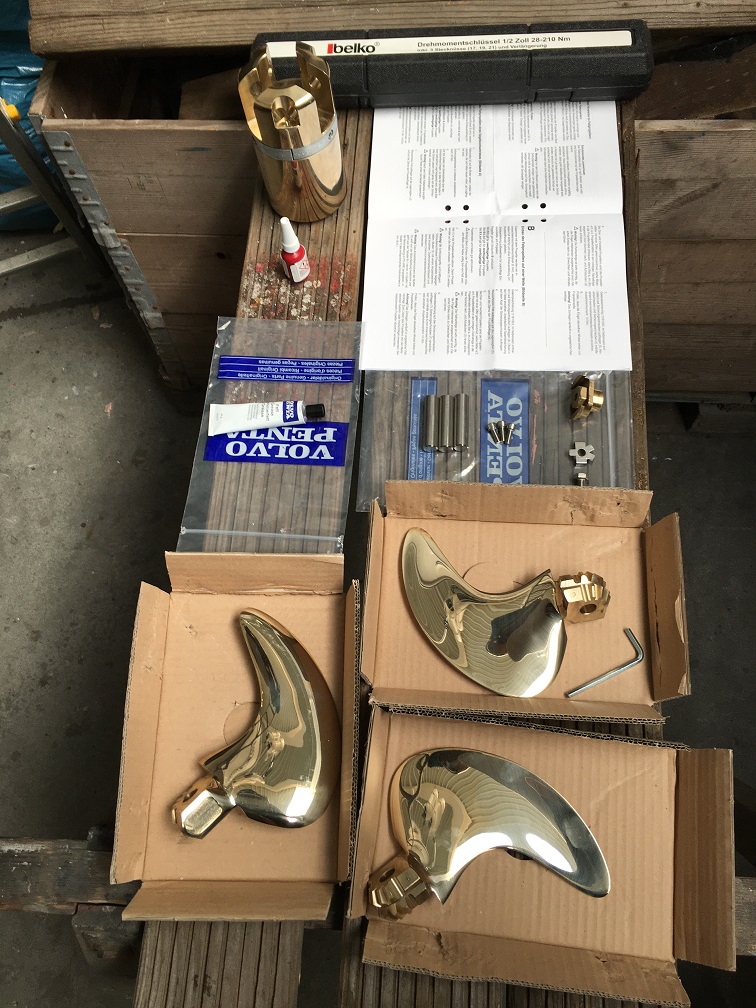
The assembly is relatively simple and can be done in a short time in winter storage. For the assembly, a short instructive manual, all necessary parts as well as waterproof grease and thread fixer are included.
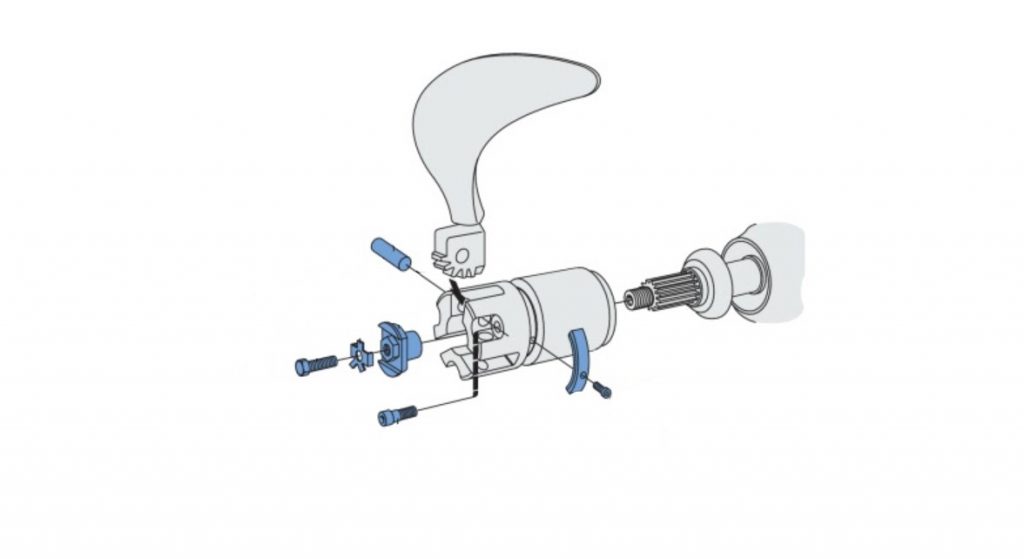
The assembly is in principle as simple as with the 2-wing propeller, except that here 3 wings are to be assembled in synchronous position and the bolts are positioned or fastened accordingly somewhat differently.
I have done it as described below, but I do not guarantee the correctness of my information: only the manufacturer’s installation instructions are decisive here.
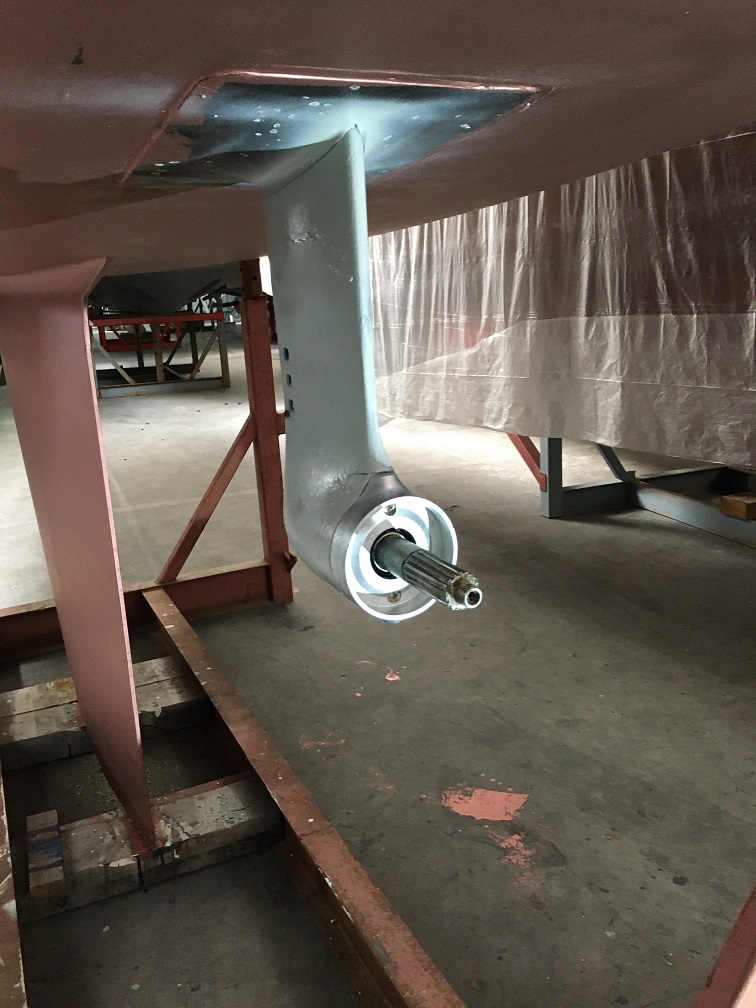
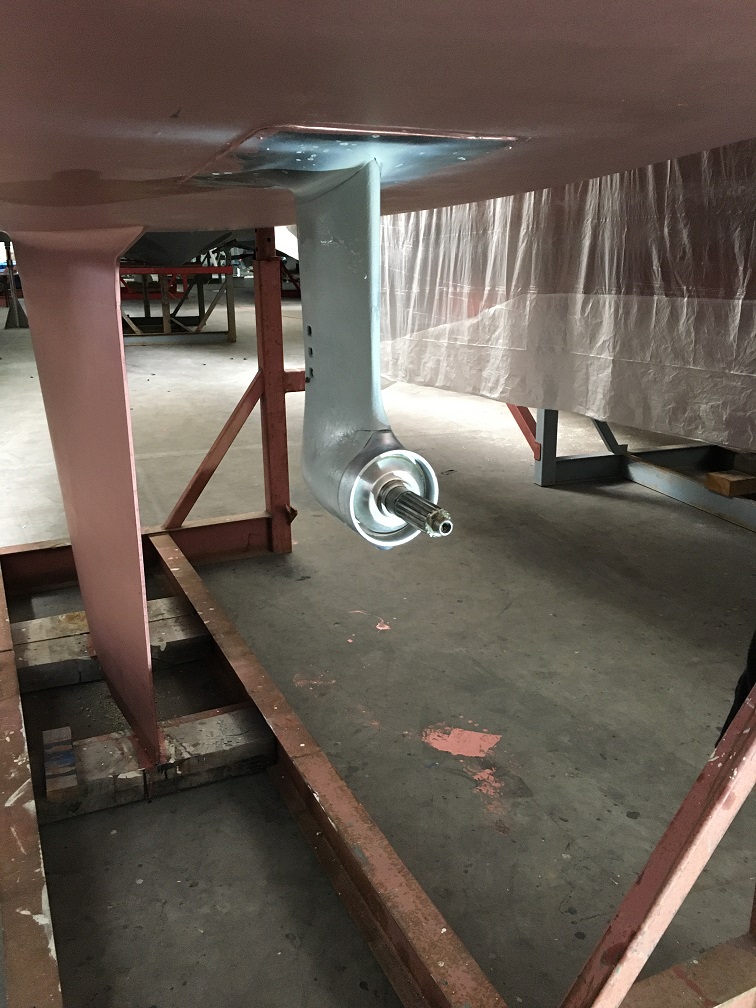
First, the new anode is pushed onto the shaft and screwed on using thread fixer.
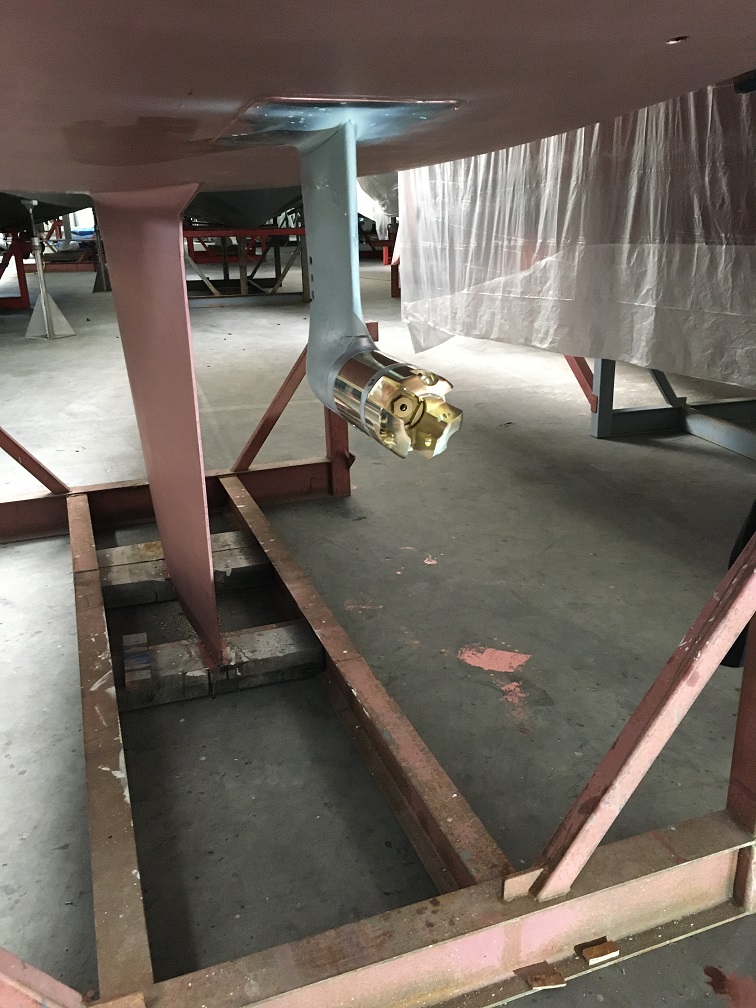
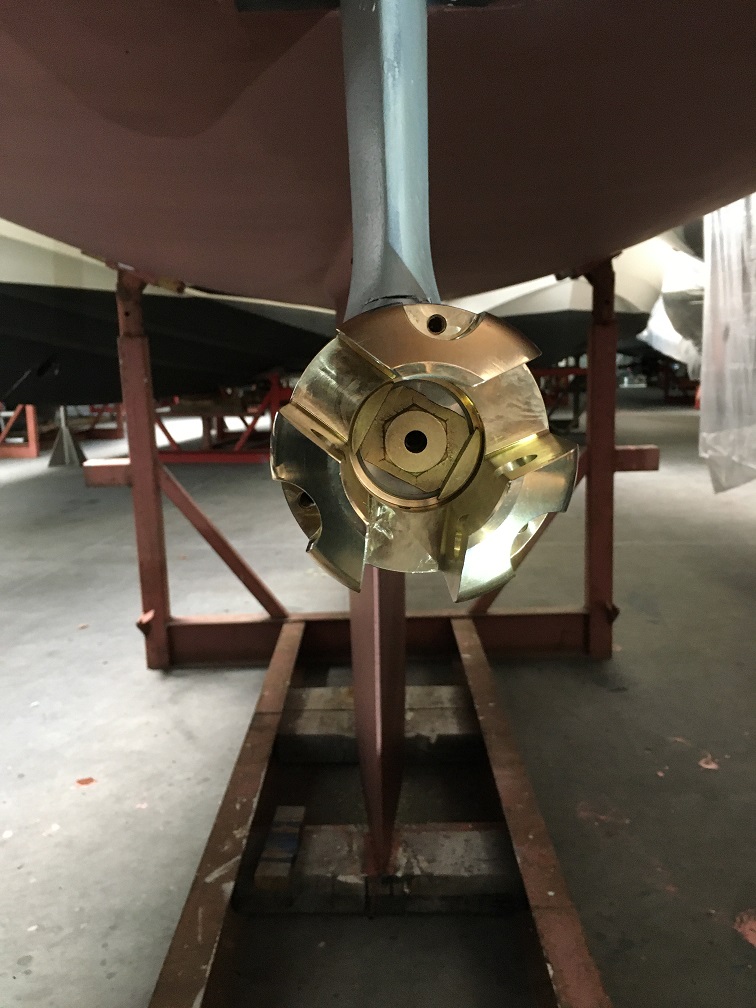
Then the shaft is lubricated with waterproof grease and then the hub is pushed onto it.
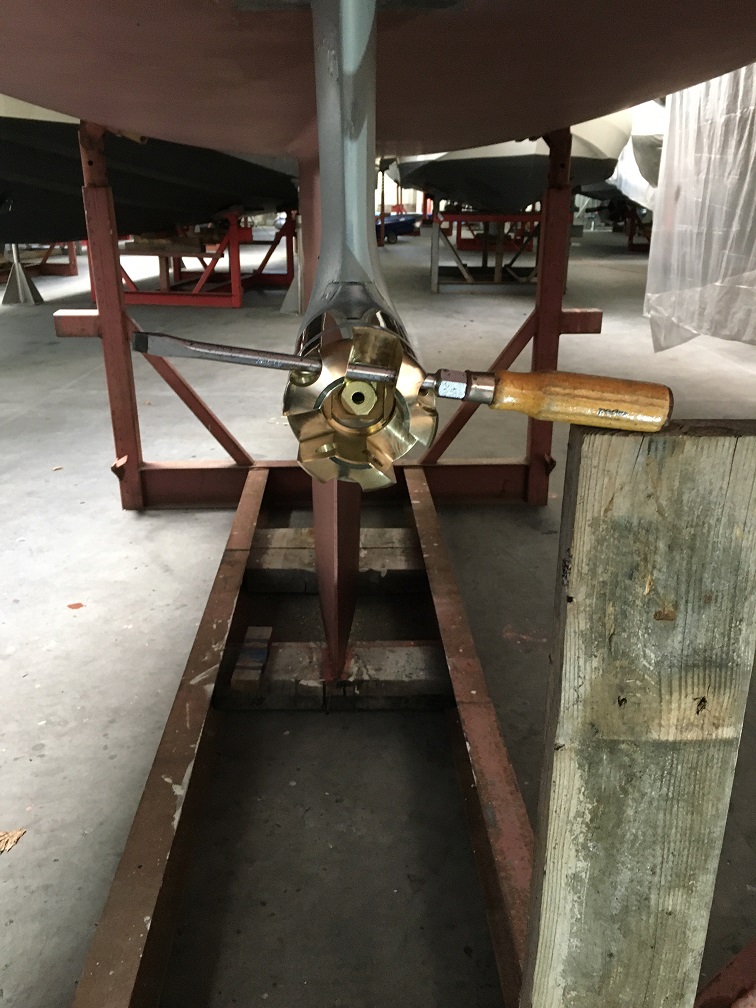
Then the hub is secured with a lock nut, which is screwed onto the thread at the end of the shaft and tightened with a torque of 70 Nm. To tighten the lock nut, the hub must be fixed. A screwdriver is helpful here, which is passed through the bolt holes and supported with a plank before the torque spanner is applied with a 24 mm nut.
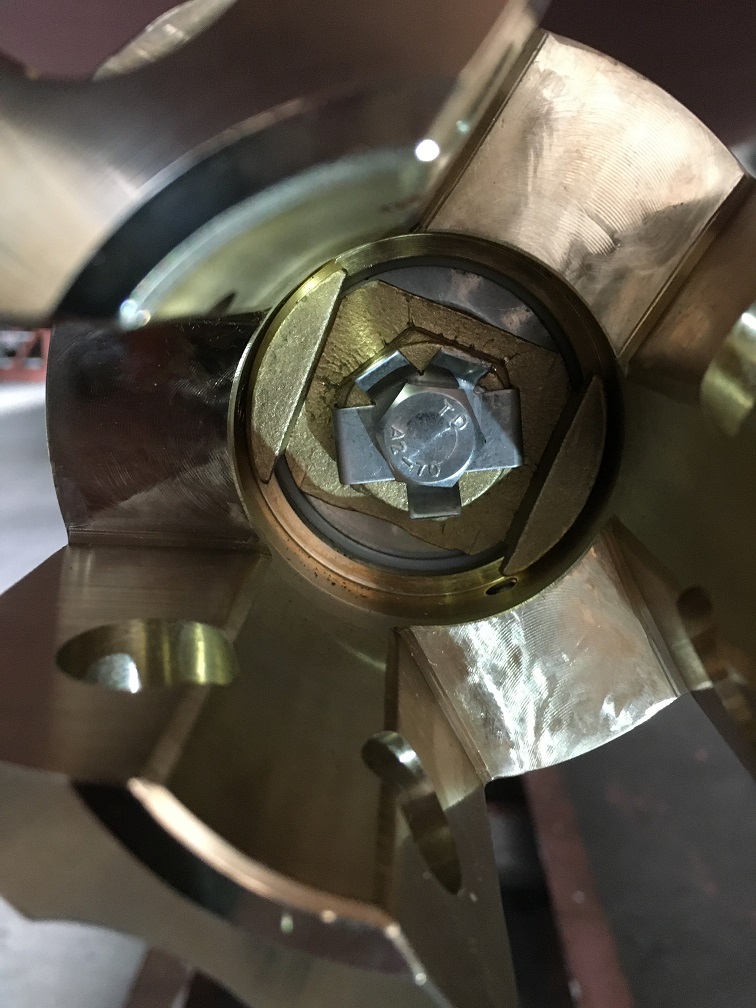

The lock nut is then secured by a locking screw, which is itself fixed with a folding washer, and tightened to 20 Nm for this purpose.

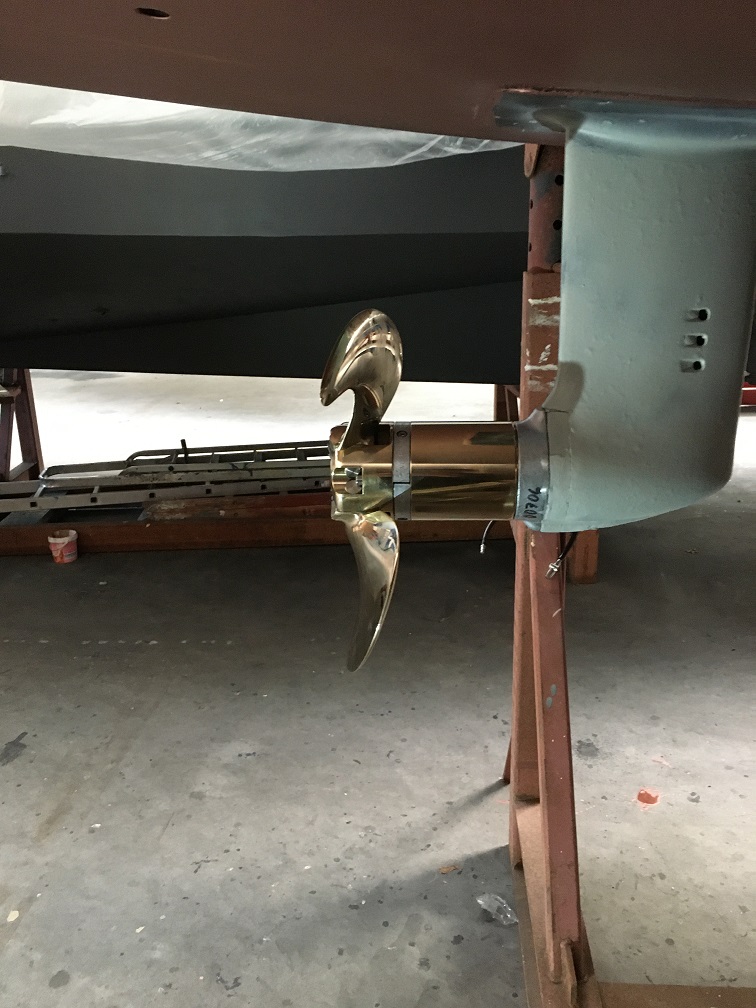
Then insert the wings with well greased sprockets. By the way, the order of installation is important here: the blades are numbered consecutively because they have been tuned for optimum smoothness in the manufacturing process. If the hub also has digits at the insertion points – which, according to the manufacturer, is not always the case – the wings must of course also be assigned to the correct digits on the hub.
The retaining bolts are slightly conical so that they can only be inserted from one side and must only be secured from this side with small Allen screws (10 Nm). Inserting the wings is a bit tricky: 3 wings and 3 bolts at the same time, so it would be best to have 3 hands for the moment. When inserting the wings, it is important that they are in exactly the same position so that they can be extended and retracted correctly and synchronously.


And this is how the propeller blades are positioned when sailing, in order to provide the least possible resistance when travelling under sail.
After launching the boat end of March, the first experiences are clearly positive.
Immediately after engaging the clutch, whether forward or backward, the pressure caused by the propeller is clearly noticeable even at the lowest speed: the ship immediately pulls in the respective direction. This was different with two-bladed propellers, where it took a few seconds at the lowest speed before the impact of the propeller was felt and the ship started to move. The effect feels more powerful and direct now when manoeuvring, which is very pleasant ….
At slow cruise speed with approx. 1,800 rpm, the ship was running approx. 5 kn STW with the 2-bladed propeller in calm conditions and without waves, now it is actually approx. 5.5 kn at the same rotational speed. Fantastic!
It is clear that stopping can now be done much faster and more effectively. Surprisingly, the steering effect is also stronger now; before, with the 2-wing propeller, I had hardly ever noticed it. Now its considerable and it can be easily used to push the stern up against the pier to starbord when the boat is moored alongside.
The driving noises and vibrations are now smoother and quieter, but this of cause is only a subjective feeling and not a measurement.
All in all, the change to a 3 blade propeller is a good investment from my point of view and I can only recommend it.
1 Response to 3 bladed fold propeller on saildrive
Leave a Reply Cancel reply
This site uses Akismet to reduce spam. Learn how your comment data is processed.
-
Recent Posts
Recent Comments
- Calypsoskipper on Expose Finngulf 39
- Christian on Expose Finngulf 39
- Calypsoskipper on Expose Finngulf 39
- Kenneth Melcher on Expose Finngulf 39
- alex on Saildrive diaphragm – replace according to instructions or just keep?
Kalender
January 2026 M T W T F S S 1 2 3 4 5 6 7 8 9 10 11 12 13 14 15 16 17 18 19 20 21 22 23 24 25 26 27 28 29 30 31 Tags
12 V Verkabelung 12 V wiring Anchor windlass Ankerwinde Biscaya Bora Segel Bretagne Brittany Camaret sur mer circuit distribution Cornwall Cowes Cuxhaven Den Helder Diaphragm English Channel Falkenberg falkenbergs Båtsällskap Falmouth Gezeitensegeln havarie Hydrogenerator Lewmar Ocean Membrane MiniPlex-3USB-N2K Nordsee Norwegen Oxley Parasailor Plymouth Ramsgate Saildrive Saildrive diaphragm Saildrive Membrane SailingGen Seenotrettung Segeln in Tidengewässern Sjöräddnings Sällskapet Skagen Skagerak Stromkreisverteilung tidal navigation tidal water routing Tidennavigation ÄrmelkanalArchiv
Kategorien

Da hat sich die Arbeit ja gelohnt. Was hast Du finanziell investiert für den Tausch?